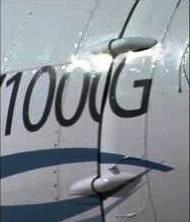Pratt & Whitney at the end of April will mate the first Bombardier CSeries prototype nacelle, built by Goodrich, to its PW1524G engine number two turbofan prototype in Mirabel for flight tests on the company's Boeing 747SP flying test bed starting mid-year.
The resulting trials will provide the first glimpse of true performance of the PW1524G's unique variable area nozzle (VAN) nacelle, a FADEC-controlled feature that P&W says is an essential ingredient in making the economic case for the geared turbofan engine (GTF). The GTF uses a fan drive gear system to both reduce fan speed and increase low spool speed, both of which benefit the propulsive efficiency of the engine.
 |
|---|
©PRATT&WHITNEY |
PW1524G test engine one in West Palm Beach |
In the "open" or widest position, the VAN protects against fan resonance, or flutter, on takeoff and reverse-thrust operations. In the closed position in cruise flight, the device is designed to cut fuel consumption by 2%; and in an intermediate position, it can in theory boost "time-to-climb" performance or cut noise, key metrics airlines must consider when operating 500nm stage length aircraft like the CSeries.
"It's a 'third knob' on an engine," says Alan Epstein, P&W's vice-president of technology and environment. "Previously we had controls for fuel flow and the variable vanes on the compressor. The GTF control system can adjust the nozzle as well".
While turbofans typically use a relatively simple fixed exit nacelle, the physics of the GTF's slow-turning, large bypass fan require the nacelle's exit to be relatively large to ensure that back-pressure does not subject the fan to potential flutter conditions at takeoff and during reverse-thrusting.
The same large-area nozzle needed to meet the high power flutter margin criteria however is inefficient for the reduced power operations at cruise, where a narrower nozzle is desired to slow the flow through the engine for optimal fan performance, hence best fuel burn.
 |
|---|
VAN in open position during 2008 A340-600 GTF tests - Airbus |
|
|
|---|
VAN in closed position - Airbus |
By using a software controlled VAN, P&W says it will be able to optimise propulsive efficiency for a variety of flight conditions while maintaining fan flutter safety margins. "Now that we've got it, we'll find all sorts of other things to do," says Epstein, adding that improving climb performance is one area where the VAN will add value.
From a test standpoint, P&W must prove out not only the performance benefits of the VAN as a function of nozzle opening, but also that failure modes will not jeopardize operations.
"If there is a problem with the VAN in terms of hardware, our electronic control has failure detection and it will keep the fan in larger area and sacrifice fuel efficiency at cruise," says Bob Saia, P&W's next-generation product family vice-president.
Saia says the prototype VAN has all the functionality of the production unit, the first of which will be delivered to P&W in November and sent into flight tests with the PW1524G in early 2012.
Source: Air Transport Intelligence news

















